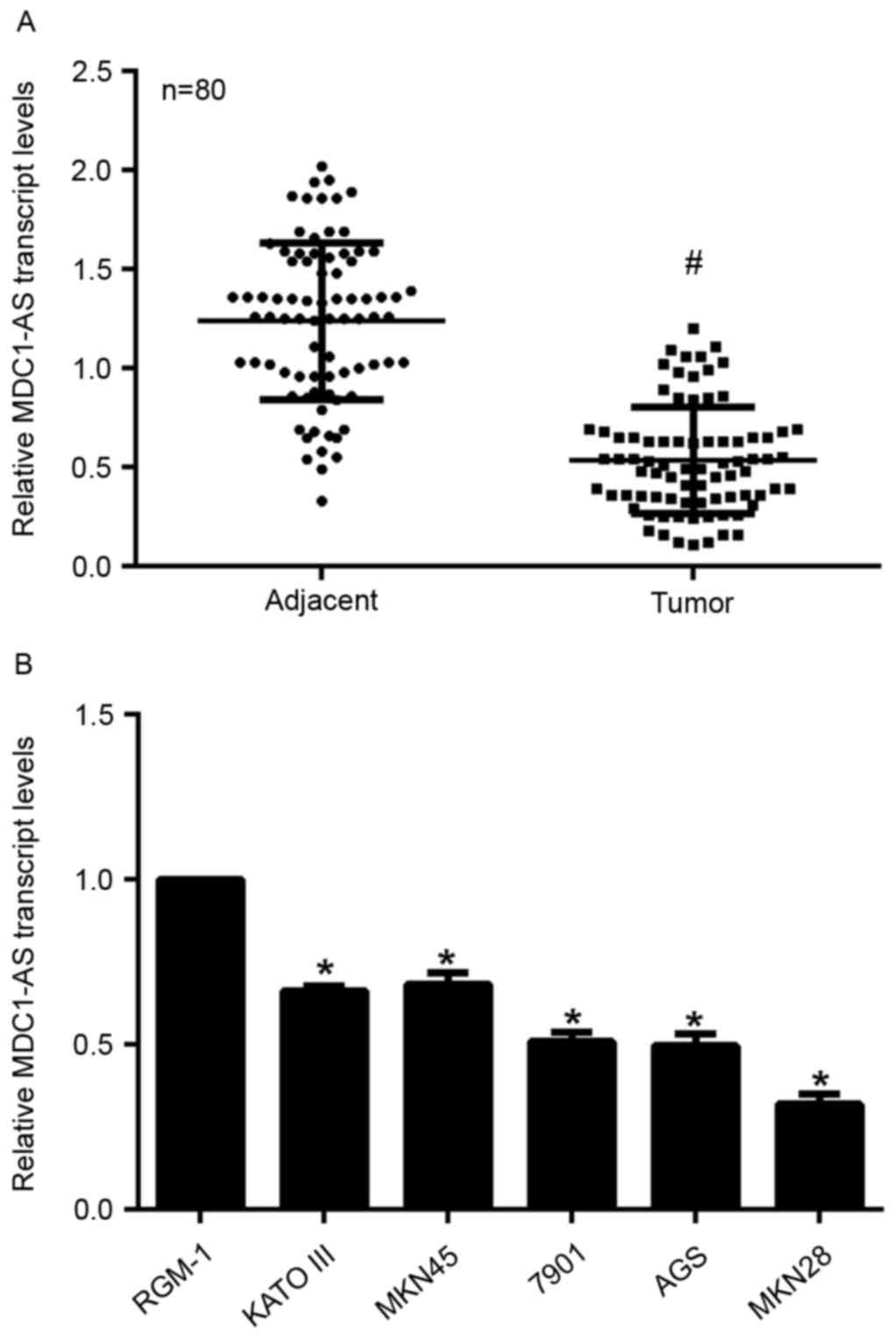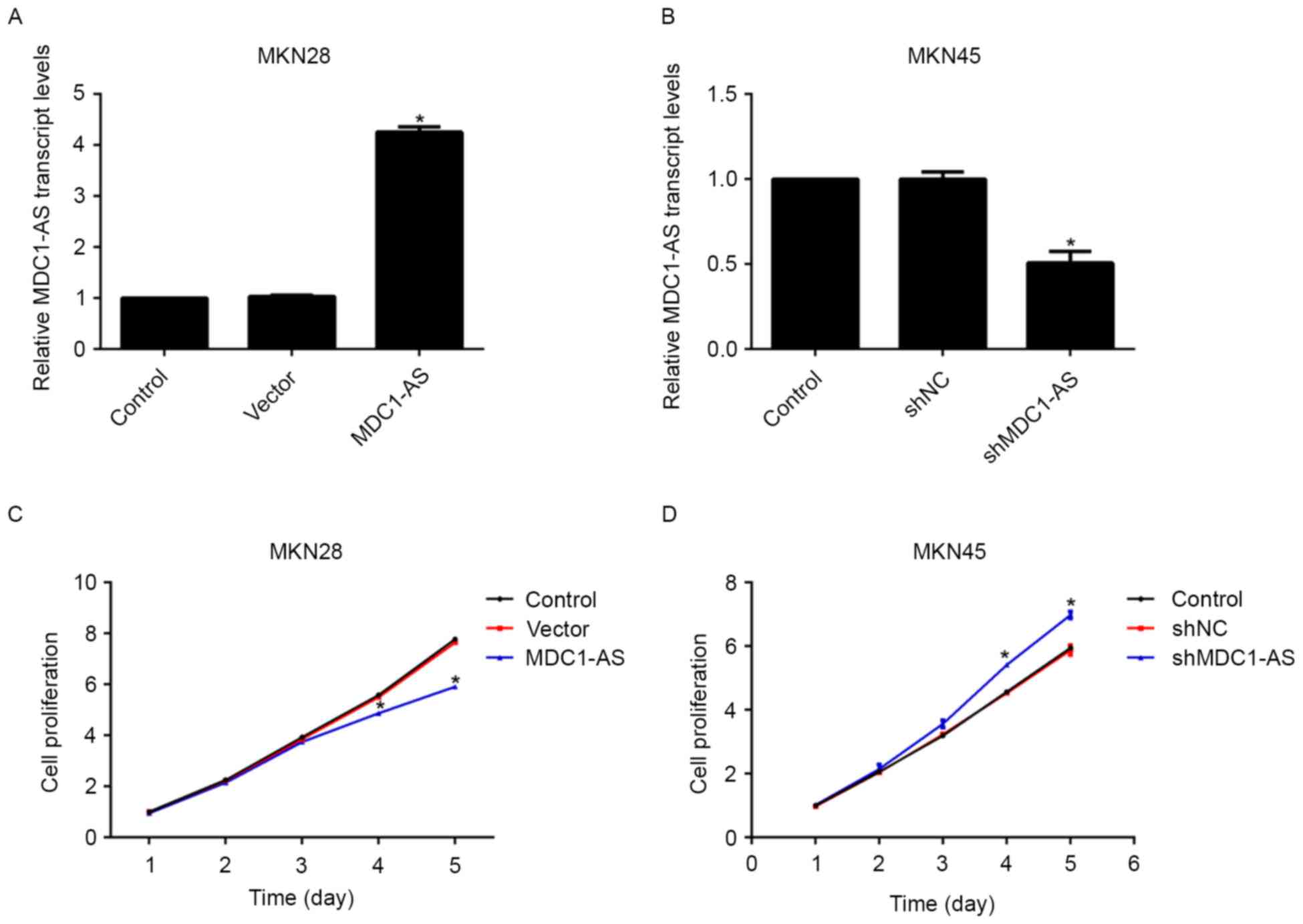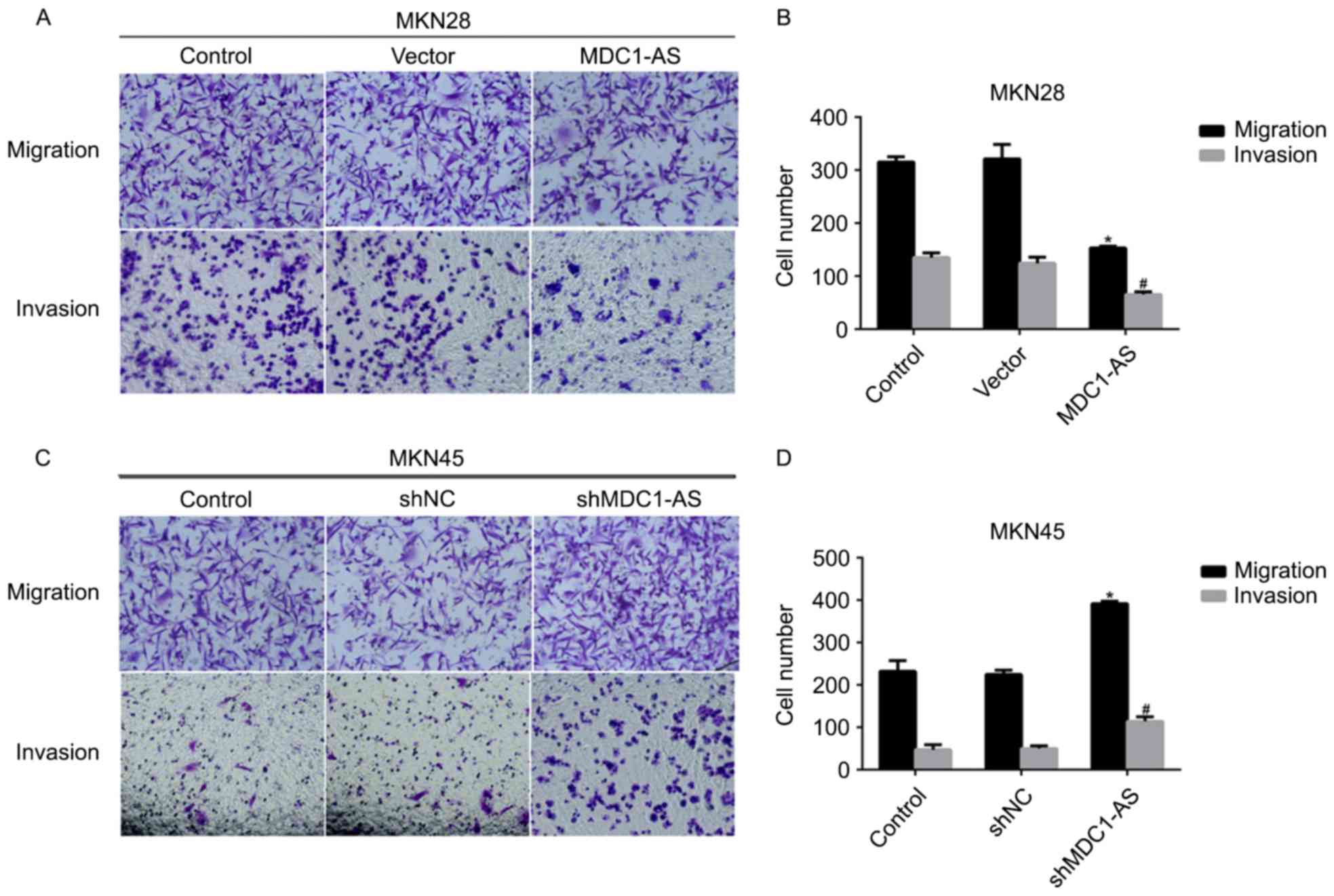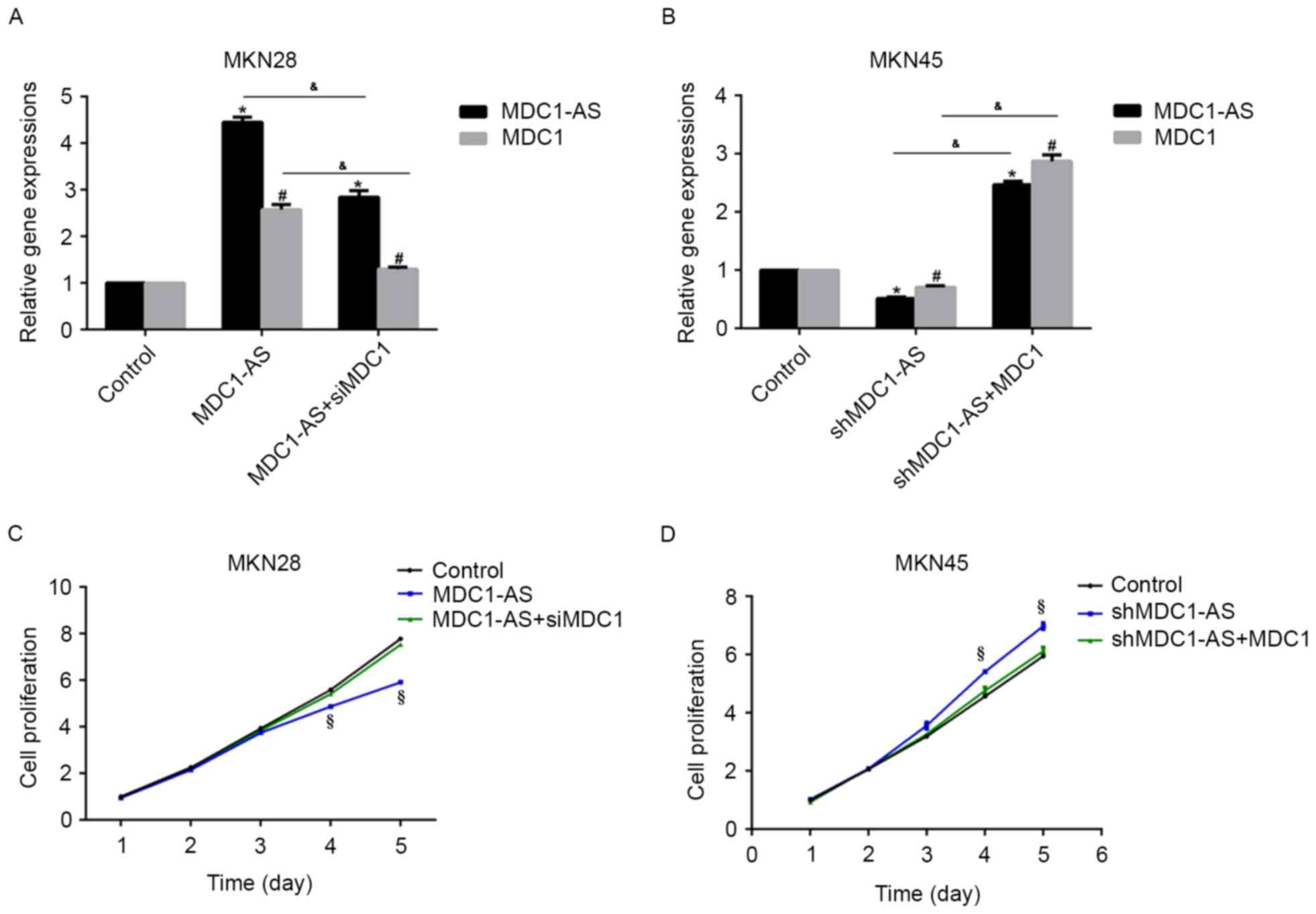Long non‑coding RNA MDC1‑AS inhibits human gastric cancer cell proliferation and metastasis through an MDC1‑dependent mechanism
- Authors:
- Published online on: October 24, 2017 https://doi.org/10.3892/etm.2017.5370
- Pages: 191-197
-
Copyright: © Qin et al. This is an open access article distributed under the terms of Creative Commons Attribution License.
Abstract
Introduction
Gastric cancer is the third leading cause of cancer-associated mortality worldwide, accounting for ~1,000,000 new cases and 738,000 mortalities each year, with a fatality rate of 0.75 (1–3). Despite advancements in diagnostic methods, gastric cancer is still frequently diagnosed at a relatively advanced stage, where patients have a median survival of <1 year (4). The incidence of gastric cancer is affected by ethnic and geographical factors; the incidence of gastric cancer is higher in Eastern Europe, Eastern Asia and South America compared with North America and Africa (5). Chemotherapy is the primary treatment for patients with gastric cancer; however, the majority of the patients will suffer from recurrence (6,7). Therefore, it is important to identify novel biomarkers for the early diagnosis of gastric cancer, in addition to novel therapeutic candidates to improve the efficacy of gastric cancer treatment.
Long non-coding (Lnc)RNAs are a class of RNAs that are >200 nucleotides in length and do not encode proteins due to a lack of open reading frames (8,9). According to the GENCODE project analysis (version 23), 27,817 transcripts from 15,931 genes were identified as LncRNAs (10). Accumulating evidence has demonstrated the significant roles served by LncRNAs in various homeostatic processes, including cellular differentiation (11), gene imprinting (12) and tumorigenesis (13). In addition, the aberrant expression of LncRNAs in multiple tissues is frequently associated with tumorigenesis. Recently, the roles of certain LncRNAs in the tumorigenesis of gastric cancer were elucidated. For example, the LncRNA ZNFX1 antisense RNA 1 was reported to markedly promote gastric cancer cell proliferation and metastasis by epigenetically repressing the expression of Kruppel like factor 2 and naked cuticle homolog 2 (14). The LncRNA RNA component of mitochondrial RNA processing endoribonuclease was demonstrated to increase gastric carcinogenesis by acting as a microRNA-206 regulator and is therefore a novel therapeutic target for the treatment of gastric cancer (15). However, the underlying molecular mechanisms of how these LncRNAs regulate tumorigenesis remains unknown, whilst the effects of other LncRNAs remain unclear.
Mediator of DNA damage checkpoint protein 1 (MDC1) serves a key role in the repair of DNA double-strand breaks and acts as a tumor suppressor in bladder cancer (16). The antisense transcript of MDC1, MDC1-antisense RNA (MDC1-AS), was recently identified as a novel LncRNA in bladder cancer (16). Another study demonstrated that the relative transcript level of MDC1-AS was decreased in bladder cancer and glioma (17). In addition, overexpression of MDC1-AS promoted human glioma cell proliferation and shifted the cell cycle in an MDC1-dependent manner (17). However, the molecular mechanism underlying this effect and the role of MDC1-AS in gastric cancer remains unclear.
The present study examined the expression of MDC1-AS in gastric cancer in vivo and in vitro. The overexpression of MDC1-AS in poorly differentiated MKN28 cells inhibited, whereas knockdown of MDC1-AS in well-differentiated MKN45 cells increased the cellular proliferation rate and metastatic potential. Alteration of the expression of MDC1 relieved this inhibitory effect of MDC1-AS in gastric cancer cells. The results of the present study revealed the oncogenic potential of MDC1-AS in human gastric cancer, indicating that MDC1-AS may serve as a novel therapeutic target for the diagnosis and treatment of gastric cancer in the clinic.
Materials and methods
Human samples
A total of 80 patients (mean age, 50±5, male:female, 51:29) with gastric cancer were recruited from Shenzhen Second People's Hospital (Shenzhen, China) between May 2014 to May 2015. No patients had received radiotherapy or chemotherapy prior to surgery. Written consent was obtained from each patient. Tumor tissues and adjacent non-cancerous tissues were collected during the gastric tumor resection, immediately frozen in liquid nitrogen and stored until required for analysis. None of the patients received radiotherapy or chemotherapy prior to surgery. The present study was approved by the Ethics Committee of Shenzhen Second People's Hospital.
Cell culture and transfection
The rat normal gastric epithelial cell RGM-1, and the gastric cancer cell lines KATO III, SGC-7901 and AGS were purchased from the American Type Culture Collection (Manassas, VA, USA). The gastric cancer cell lines MN45 and MKN28 were purchased from the Type Culture Collection of the Chinese Academy of Sciences (Shanghai, China). The cell line MKN28 is known to be an MKN74 derivative, which is also a gastric adenocarcinoma cell line (17). All cells were cultured in Dulbecco's modified Eagle's medium (DMEM) supplemented with 10% fetal bovine serum (FBS) (both Gibco; Thermo Fisher Scientific, Inc., Waltham, MA, USA) at 37°C in a humidified incubator with 5% CO2. Plasmid, short hairpin (sh)RNA and small interfering (si)RNA transfection was conducted using Lipofectamine® 2000 (Thermo Fisher Scientific, Inc.) according to the manufacturer's protocol. pcDNA 3.1 vector with MDC1-AS and MDC1 overexpression were established by our lab using the polymerase chain reaction (PCR). shRNAs and siRNAs were designed and synthesized by Shanghai GenePharma Co., Ltd. (Shanghai, China). Sequences were not released by the company. Plasmids and sh/siRNAs were dissolved in distilled water to produce a stock solution.
RNA extraction and reverse transcription-quantitative (RT-q) PCR analysis
RNAs from the tissue samples and cultured cells were extracted using TRIzol reagent (Takara Biotechnology Co., Ltd., Dalian, China) in an RNase free atmosphere according to the manufacturer's protocol. cDNA was then reverse transcribed using a Takara Biotechnology Co., Ltd. kit (Transcriptor First Strand cDNA Synthesis kit) according to the manufacturers's instructions (37°C for 15 min and 85°C for 5 sec). qPCR analysis with SybrGreen reagent (Takara Bio, Inc., Otsu, Japan) was performed with the following primers: MDC1-AS forward, 5′-TCCCAGATGTGCCAAAGTCAG-3′ and reverse, 5′-AGCAACCCCAGTTGTCATTC-3′; MDC1 forward, 5′-GCAGCTTCCAGACAACAG-3′ and reverse, 5′-TACCCATGACTTTATCCACA-3′; and GAPDH forward, 5′-AAGGTGAAGGTCGGAGTCAAC-3′ and reverse, 5′-GGGGTCATTGATGGCAACAATA-3′. GAPDH was used as an internal control. The thermocycling conditions were as follows: 95°C for 5 min, followed by 40 cycles of 95°C for 15 sec and 60°C for 30 sec. The expression of MDC1-AS and MDC1 was quantified using the 2−∆∆Cq method (18).
Cell proliferation assay
Cell proliferation was determined by bromodeoxyuridine (BrdU) incorporation (EMD Millipore, Billerica, MA, USA). Briefly, a total of 1×103 MKN28 cells were transfected with the MDC1-AS overexpressing plasmid with or without siRNA targeting MDC1 (siMDC1), and MKN45 cells were transfected with shRNA directed against MDC1-AS in the presence or absence of an MDC1 expression plasmid in a 6-well plate. The cells were then cultured for 48 h at 37°C. Then, the cells were washed and the DMEM was replaced with serum-free media for 24 h. Subsequently, the cells were washed with PBS, trypsinized for ~3 sec at 37°C and collected by centrifugation at 850 g for 5 min. Equal numbers of MKN28 or MKN45 cells (5,000) from each group were then seeded into 96-well plates and incubated in DMEM supplemented with 10% FBS and 10 µM BrdU for 30 min. BrdU incorporation was detected with additional peroxidase substrates according to the manufacturer's protocols. The absorbance of the wells at a wavelength of 450 nm was measured using a microplate reader.
Transwell migration and invasions assays
Cell migration and invasion were explored using Transwell® chambers (pore size, 8 µm; Corning Incorporated, Corning, NY, USA). For the migration assay, MKN28 and MKN45 cells were transfected and collected as described above. Afterwards, 5×104 cells in serum-free media were seeded into the upper chamber and 600 µl of DMEM supplemented with 10% FBS was added into the lower chamber. After incubation for 24 h at 37°C, the cells were fixed with ice-cold methanol for 5 min and stained with crystal violet (0.1%) at room temperature for 5 min. The membrane was washed in water three times and cells on the upper surface were removed using cotton swabs. Cells on the lower surface were imaged at a magnification, ×100 and the number of cells in five random fields of view were counted using a light microscope. For the invasion assay, the membranes of the chambers were pre-coated with Matrigel (Corning Incorporated) at 37°C for 6 h.
Wound healing assay
Wound-healing assays were performed by creating identical ‘wounds’ using 10 µl sterile pipette tips. Briefly, a total of 1×104 cells/well were seeded into 6-well plates and co-incubated with the plasmids and/or sh/siRNAs described above for 48 h. Afterwards, the cells were washed with PBS and a ‘wound’ was created across the center of each well. Then plates were then washed again and fresh serum-free medium was immediately added. After 24 h incubation at 37°C, cells were observed and imaged under a light microscope at a magnification of ×200. Five random fields of view were selected and the percentage of wound closure was calculated (ImageJ Software; version 2; National Institutes of Health; Bethesda, MD, USA.
Statistical analysis
All results are presented as the mean ± standard derivation, unless otherwise stated. The student's t-test was used to analyze the statistical significance of differences between variables. All statistical analyses were performed using SPSS software (version 18.0; SPSS, Inc., Chicago, IL, USA). P<0.05 was considered to indicate a statistically significant difference.
Results
MDC1-AS expression is decreased in human gastric cancer in vivo and in vitro
Samples from a total of 80 gastric cancer patients were collected in the present study and subjected to RT-qPCR analysis. As shown in Fig. 1A, the relative transcript level of MDC1-AS in tumor tissues was significantly decreased compared with that in their adjacent non-cancerous tissues. RGM-1 cells are derived from normal rat gastric epithelial tissue, while KATO III, MKN45, SGC-7901, AGS and MKN28 cells are human gastric cancer cells with increased migration abilities. KATO III and MKN45 cells are well differentiated, SGC-7901 and AGS cells are moderately differentiated and MKN28 cells are poorly differentiated. The expression of MDC1-AS was measured in these cell lines and it was identified that MDC1-AS expression was significantly suppressed in all five of the gastric cancer cell lines compared with the RGM-1 cells (Fig. 1B). Notably, the relative MDC1-AS transcript level was decreased as the level of differentiation of the cancer cells decreased. Among the five cancer cell lines, MKN28 and MKN45 cells exhibited the lowest and highest expression of MDC1-AS, respectively (Fig. 1B). Thus, MKN28 and MKN45 cells were selected for the subsequent experiments. These data indicate that the expression of MDC1-AS is suppressed in human gastric cancer cells in vivo and in vitro.
MDC1-AS inhibits the proliferation of human gastric cancer cells
The effect of MDC1-AS on the proliferation of gastric cancer cells was investigated in the present study. An MDC1-AS-expressing plasmid and shRNA targeting MDC1-AS were transfected into MKN28 and MKN45 cells, respectively. Upon plasmid treatment, the relative transcript level of MDC1-AS in the MKN28 cells was significantly increased by 4-fold compared with the control group (Fig. 2A). The expression of MDC1-AS in MKN45 cells was suppressed to 50% of the preliminary baseline after shRNA treatment (Fig. 2B). Afterwards, the effect of MDC1-AS on cell proliferation was examined using cell viability assays. No significant difference in cell proliferation was observed between the three groups of MKN28 and MKN45 cell lines in the 3 days following plasmid or shRNA transfection (Fig. 2C and D). However, the proliferative rate of MKN28 cells was significantly inhibited by 13% on day 4 and 24% on the day 5 after transfection with the MDC1-AS-expressing plasmid compared with the control cells (Fig. 2C). Conversely, MKN45 cell proliferation was increased significantly by 16 and 15% on the days 4 and 5, respectively, after shMDC1-AS transfection (Fig. 2D). These results suggest that MDC1-AS suppresses the proliferation of human gastric cancer cells.
MDC1-AS inhibits the metastasis of human gastric cancer cells
Cell proliferation and metastasis are hallmarks of cancer, including gastric cancer. Therefore, the role of MDC1-AS in gastric cancer cell metastasis was investigated with Transwell assays. MKN28 cells were transfected with an MDC1-AS-expressing plasmid and MKN45 cells were treated with shRNA directed against MDC1-AS. As shown in Fig. 3A and B, after transfection MKN28 cell migration and invasion was significantly decreased compared with the control. Specifically, ~300 MKN28 cells were observed on the lower surface in the cell migration assays in the control group; however, only ~150 cells successfully migrated through the membrane in the group transfected with the MDC1-AS-expressing plasmid (Fig. 3B). Likewise, invasive potential was inhibited by >50% in the MDC1-AS plasmid treatment group compared with the control group in MKN28 cells (Fig. 3B). A similar phenomenon was observed in MKN45 cells (Fig. 3C and D). Transfection of shMDC1-AS significantly increased cell migration by 43% and cell invasion by 60% in MKN45 cells (Fig. 3D). These results indicate that MDC1-AS inhibits the metastasis of human gastric cancer cells.
Knockdown of MDC1 relieves the inhibitory effect of MDC1-AS on human gastric cancer cell proliferation
The expression of MDC1 has been reported to involved in the regulation of MDC1-AS in human bladder cancer (16); therefore, the present study examined the effect of MDC1 on the expression of MDC1-AS in human gastric cancer cells. Firstly, MKN28 cells treated with the MDC1-AS-expressing plasmid were transfected with siMDC1, and shMDC1-AS-treated MKN45 cells were transfected with an MDC1-expressing plasmid, after which RT-qPCR analysis was performed. As shown in Fig. 4A, MDC1-AS plasmid transfection significantly increased MDC1-AS and MDC1 mRNA levels compared with the control group, whereas additional siMDC1 treatment significantly suppressed MDC1-AS and MDC1 mRNA expression in MKN28 cells. Likewise, the mRNA expression of MDC1-AS and MDC1 in MN45 cells was significantly suppressed by shMDC1-AS transfection compared with the control group, whereas additional treatment with an MDC1-expressing plasmid significantly upregulated MDC1-AS and MDC1 mRNA expression compared with the control (Fig. 4B). These results indicate a potential interaction between MDC1-AS and MDC1.
Subsequently, the cell proliferation rate was investigated in these cells. The inhibitory effect of the MDC1-AS-expressing plasmid on MKN28 cell proliferation was attenuated by siMDC1 treatment (Fig. 4C). Similarly, the stimulating effect of shMCD1-AS on the proliferation of MKN45 cells was inhibited by co-transfection with the MDC1-expressing plasmid (Fig. 4D). These data suggest that MDC1-AS inhibits human gastric cancer cell proliferation through an interaction with MDC1.
Knockdown of MDC1 abolishes the suppressive effect of MDC1-AS on cell metastasis in human gastric cancer cells
The effect of MDC1 and MDC1-AS on human gastric cancer cell metastasis was investigated using wound healing assays. This revealed that wound closure was significantly increased by 70% when MKN28 cells were treated with the MDC1-AS-expressing plasmid compared with the control, whereas the percentage of wound closure was decreased to control levels after co-transfection with siMDC1 (Fig. 5A and B). Likewise, the knockdown of MDC1-AS significantly decreased wound closure in MKN45 cells; however, additional treatment with an MDC1-expressing plasmid increased the percentage of wound closure to a similar level as the control (Fig. 5C and D). These data suggest that the inhibitory effect of MDC1-AS on cell metastasis is dependent upon the expression of MDC1 in human gastric cancer cells.
Discussion
Gastric cancer is primarily caused by infection with the bacterium Helicobacter pylori, which accounts for ~60% of gastric cancer cases (19); however, the risk of developing gastric cancer is also affected by genetic and geographic factors (19). Gastric cancer can metastasize to other parts of the body, including the liver, bones and lymph nodes (20), which makes it difficult to cure since the majority of patients are diagnosed at an advanced stage (21). Therefore, novel strategies to identify gastric cancer at an early stage are required.
MDC1 is a key component of the DNA damage response machinery that is involved in the early cellular response to DNA damage in order to protect genome integrity (22). MDC1 serves an important role in the process of cell death or survival after DNA damage through regulating cellular tumor antigen p53 (23). The role of MDC1 in carcinogenesis is thus an area of interest and has been widely studied recently (16). LncRNAs can be classified by their location as follows: Intergenic, intronic, antisense and enhancer LncRNAs (24). Antisense LncRNAs are transcripts encoded on the antisense strand of DNA (25). MDC1-AS is the antisense LncRNA of MDC1, and has been demonstrated to regulate the role of MDC1 in bladder cancer (16) and glioma (17).
The present study revealed that MDC1-AS had an inhibitory effect on gastric tumorigenesis, which was dependent upon the expression of MDC1. In poorly differentiated MKN28 cells, the transfection of an MDC1-AS expression plasmid suppressed cell proliferation and metastasis; however, when the cells were co-transfected with siMDC1 this effect was inhibited, indicating that the effect of MDC1-AS is dependent upon MDC1. This hypothesis was also verified in the well-differentiated gastric cancer cell line MKN45. Knockdown of MDC1-AS in MKN45 cells increased proliferation and metastasis, while co-transfection with an MDC-1-expressing plasmid inhibited this effect. However, the exact molecular mechanisms by which MDC1 affects the function of MDC1-AS requires further study.
In conclusion, the present study demonstrated that the expression of the LncRNA MDC1-AS was suppressed in human gastric cancer cells in vitro and in vivo. In addition, the overexpression of MDC1-AS in MKN28 cells inhibited proliferation, migration and invasion, while the knockdown of MDC1-AS in MKN45 cells promoted these hallmarks of cancer. This inhibitory effect of MDC1-AS on tumorigenesis was identified to be MDC1-dependent. These findings indicate that MDC1-AS is a tumor suppressor, which may provide new directions for the diagnosis and treatment of gastric cancer in the clinic.
References
|
Ferlay J, Soerjomataram I, Dikshit R, Eser S, Mathers C, Rebelo M, Parkin DM, Forman D and Bray F: Cancer incidence and mortality worldwide: Sources, methods and major patterns in GLOBOCAN 2012. Int J Cancer. 136:E359–E386. 2015. View Article : Google Scholar : PubMed/NCBI | |
|
Jemal A, Bray F, Center MM, Ferlay J, Ward E and Forman D: Global cancer statistics. CA Cancer J Clin. 61:69–90. 2011. View Article : Google Scholar : PubMed/NCBI | |
|
Torre LA, Bray F, Siegel RL, Ferlay J, Lortet-Tieulent J and Jemal A: Global cancer statistics, 2012. CA Cancer J Clin. 65:87–108. 2015. View Article : Google Scholar : PubMed/NCBI | |
|
Cunningham D, Okines AF and Ashley S: Capecitabine and oxaliplatin for advanced esophagogastric cancer. N Engl J Med. 362:858–859. 2010. View Article : Google Scholar : PubMed/NCBI | |
|
Nagini S: Carcinoma of the stomach: A review of epidemiology, pathogenesis, molecular genetics and chemoprevention. World J Gastrointest Oncol. 4:156–169. 2012. View Article : Google Scholar : PubMed/NCBI | |
|
Kamangar F, Dores GM and Anderson WF: Patterns of cancer incidence, mortality, and prevalence across five continents: Defining priorities to reduce cancer disparities in different geographic regions of the world. J Clin Oncol. 24:2137–2150. 2006. View Article : Google Scholar : PubMed/NCBI | |
|
Ferlay J, Shin HR, Bray F, Forman D, Mathers C and Parkin DM: Estimates of worldwide burden of cancer in 2008: GLOBOCAN 2008. Int J Cancer. 127:2893–2917. 2010. View Article : Google Scholar : PubMed/NCBI | |
|
Li R, Zhu H and Luo Y: Understanding the functions of long non-coding RNAs through their higher-order structures. Int J Mol Sci. 17:pii: E7022016. View Article : Google Scholar | |
|
Qi P, Zhou XY and Du X: Circulating long non-coding RNAs in cancer: Current status and future perspectives. Mol Cancer. 15:392016. View Article : Google Scholar : PubMed/NCBI | |
|
Harrow J, Frankish A, Gonzalez JM, Tapanari E, Diekhans M, Kokocinski F, Aken BL, Barrell D, Zadissa A, Searle S, et al: GENCODE: The reference human genome annotation for the ENCODE project. Genome Res. 22:1760–1774. 2012. View Article : Google Scholar : PubMed/NCBI | |
|
Fatica A and Bozzoni I: Long non-coding RNAs: New players in cell differentiation and development. Nat Rev Genet. 15:7–21. 2014. View Article : Google Scholar : PubMed/NCBI | |
|
Pauli A, Rinn JL and Schier AF: Non-coding RNAs as regulators of embryogenesis. Nat Rev Genet. 12:136–149. 2011. View Article : Google Scholar : PubMed/NCBI | |
|
Qi P, Zhou XY and Du X: Circulating long non-coding RNAs in cancer: Current status and future perspectives. Mol Cancer. 15:392016. View Article : Google Scholar : PubMed/NCBI | |
|
Nie F, Yu X, Huang M, Wang Y, Xie M, Ma H, Wang Z, De W and Sun M: Long noncoding RNA ZFAS1 promotes gastric cancer cells proliferation by epigenetically repressing KLF2 and NKD2 expression. Oncotarget. 8:38227–38238. 2017.PubMed/NCBI | |
|
Shao Y, Ye M, Li Q, Sun W, Ye G, Zhang X, Yang Y, Xiao B and Guo J: LncRNA-RMRP promotes carcinogenesis by acting as a miR-206 sponge and is used as a novel biomarker for gastric cancer. Oncotarget. 7:37812–37824. 2016. View Article : Google Scholar : PubMed/NCBI | |
|
Xue Y, Ma G, Zhang Z, Hua Q, Chu H, Tong N, Yuan L, Qin C, Yin C, Zhang Z and Wang M: A novel antisense long noncoding RNA regulates the expression of MDC1 in bladder cancer. Oncotarget. 6:484–493. 2015. View Article : Google Scholar : PubMed/NCBI | |
|
Yue H, Zhu J, Xie S, Li F and Xu Q: MDC1-AS, an antisense long noncoding RNA, regulates cell proliferation of glioma. Biomed Pharmacother. 81:203–209. 2016. View Article : Google Scholar : PubMed/NCBI | |
|
Livak KJ and Schmittgen TD: Analysis of relative gene expression data using real-time quantitative PCR and the 2(-Delta Delta C(T)) method. Methods. 25:402–408. 2001. View Article : Google Scholar : PubMed/NCBI | |
|
Chang AH and Parsonnet J: Role of bacteria in oncogenesis. Clin Microbiol Rev. 23:837–857. 2010. View Article : Google Scholar : PubMed/NCBI | |
|
Ruddon RW: Introduction to the molecular biology of cancer: Translation to the clinic. Prog Mol Biol Transl Sci. 95:1–8. 2010. View Article : Google Scholar : PubMed/NCBI | |
|
Montenegro RC, Clark PG, Howarth A, Wan X, Ceroni A, Siejka P, Nunez-Alonso GA, Monteiro O, Roger C, Gamble V, et al: BET inhibition as a new strategy for the treatment of gastric cancer. Oncotarget. 7:43997–44012. 2016. View Article : Google Scholar : PubMed/NCBI | |
|
Stewart GS, Wang B, Bignell CR, Taylor AM and Elledge SJ: MDC1 is a mediator of the mammalian DNA damage checkpoint. Nature. 421:961–966. 2003. View Article : Google Scholar : PubMed/NCBI | |
|
Nakanishi M, Ozaki T, Yamamoto H, Hanamoto T, Kikuchi H, Furuya K, Asaka M, Delia D and Nakagawara A: NFBD1/MDC1 associates with p53 and regulates its function at the crossroad between cell survival and death in response to DNA damage. J Biol Chem. 282:22993–23004. 2007. View Article : Google Scholar : PubMed/NCBI | |
|
Derrien T, Johnson R, Bussotti G, Tanzer A, Djebali S, Tilgner H, Guernec G, Martin D, Merkel A, Knowles DG, et al: The GENCODE v7 catalog of human long noncoding RNAs: Analysis of their gene structure, evolution, and expression. Genome Res. 22:1775–1789. 2012. View Article : Google Scholar : PubMed/NCBI | |
|
Morris KV and Vogt PK: Long antisense non-coding RNAs and their role in transcription and oncogenesis. Cell Cycle. 9:2544–2547. 2010. View Article : Google Scholar : PubMed/NCBI |














